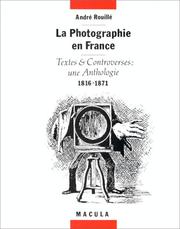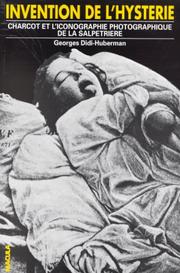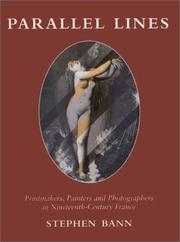| Listing 1 - 10 of 15 | << page >> |
Sort by
|

ISBN: 286589021X 9782865890217 Year: 1989 Publisher: Paris : Macula,
Abstract | Keywords | Export | Availability | Bookmark
 Loading...
Loading...Choose an application
- Reference Manager
- EndNote
- RefWorks (Direct export to RefWorks)
Photography --- Photographie --- History --- Sources --- Histoire --- Sources. --- 77 <44> --- 77 "18" --- -Fotografie--Frankrijk --- Fotografie--19e eeuw. Periode 1800-1899 --- -Sources --- -77 "18" Fotografie--19e eeuw. Periode 1800-1899 --- 77 <44> Fotografie--Frankrijk --- Fotografie--Frankrijk --- 77.035 --- CDL --- -77 <44> Fotografie--Frankrijk --- Fotografie--19e eeuw. Periode 1800-1899v --- History&delete& --- Photography - France - History - Sources. --- France --- 19e siècle
Book
Year: 1965 Publisher: Paris : Vincent, Fréal et Cie,
Abstract | Keywords | Export | Availability | Bookmark
 Loading...
Loading...Choose an application
- Reference Manager
- EndNote
- RefWorks (Direct export to RefWorks)
77 "18" --- 77 <44> --- Fotografie--19e eeuw Periode 1800-1899. --- Fotografie--Frankrijk.
Book
ISBN: 9782021143775 2021143775 Year: 2013 Publisher: Paris Seuil
Abstract | Keywords | Export | Availability | Bookmark
 Loading...
Loading...Choose an application
- Reference Manager
- EndNote
- RefWorks (Direct export to RefWorks)
Photographers --- Photographes --- Exhibitions. --- Expositions --- Depardon, Raymond --- 77 DEPARDON, RAYMOND --- 77.044 --- 77 <44> --- 77.044 Nieuwsfotografie. Reportage --- Nieuwsfotografie. Reportage --- 77 <44> Fotografie--Frankrijk --- Fotografie--Frankrijk --- 77 DEPARDON, RAYMOND Fotografie--DEPARDON, RAYMOND --- Fotografie--DEPARDON, RAYMOND --- Exhibitions
Book
ISBN: 2717722904 9782717722901 Year: 2004 Publisher: Paris Bibliothèque nationale de France
Abstract | Keywords | Export | Availability | Bookmark
 Loading...
Loading...Choose an application
- Reference Manager
- EndNote
- RefWorks (Direct export to RefWorks)
77 <44>
---
77 "18"
---
779
---
#BIBC:ruil
Book

ISBN: 9783037642030 3037642033 Year: 2013 Publisher: Zürich JRP/Ringier
Abstract | Keywords | Export | Availability | Bookmark
 Loading...
Loading...Choose an application
- Reference Manager
- EndNote
- RefWorks (Direct export to RefWorks)
Monographie de référence : un panorama complet de l'œuvre de l'artiste franco-marocaine. Introduite par une préface de l'auteur espagnol Juan Goytisolo, cette monographie de référence comprend un essai rétrospectif de la critique d'art et commissaire d'expositions Marie Muracciole, un essai visuel de l'historien d'art et théoricien Jean-François Chevrier et une conversation entre l'artiste et Sina Najafi, éditeur en chef du magazine Cabinet. Ces textes ainsi qu'une large sélection de travaux offrent un panorama complet de l'œuvre d'Yto Barrada, un corpus où, à partir de ce lieu spécifique qu'est Tanger, il est question d'histoire et de géographique, d'histoires de famille et de mémoires superposées. Depuis le début des années 2000, l'artiste franco-marocaine Yto Barrada (née en 1971, vit à New York et à Tanger) mène une réflexion, déployée selon une perspective non occidentale, sur les changements géopolitiques actuels, l'histoire postcoloniale et les enjeux locaux de la mondialisation. Après des études à l'International Center of Photography (New York), elle se fait remarquer en 2005 avec l'ensemble « Une vie plein de trous – Le Projet du Détroit ». Dans cette vaste série photographique, lauréate du prix Ellen Auerbach en 2006 (Yto Barrada est par ailleurs lauréate de l'Abraaj Group Art Prize en 2014), elle offre un portrait inattendu de sa ville natale, Tanger. Essentiellement photographique, son œuvre comprend également des films, des sculptures et installations ainsi que des publications qui, ensemble, composent une pratique singulière entre stratégies documentaires et approche méditative des images. Yto Barrada est la fondatrice et directrice de la Cinémathèque de Tanger.
Photography --- Photographie --- Barrada, Yto, --- Exhibitions --- Installation-art --- Sculpture --- Barrada, Yto --- 77 BARRADA, YTO --- 77 <44> --- kunst --- 7.071 BARRADA --- 77.071 BARRADA --- stedelijkheid --- kunst en stedelijkheid --- kunst en politiek --- Tangiers --- Tanger --- Marokko --- eenentwintigste eeuw --- Frankrijk --- kunst en fotografie --- fotografie --- Fotografie--BARRADA, YTO --- Fotografie--Frankrijk --- 77 <44> Fotografie--Frankrijk --- 77 BARRADA, YTO Fotografie--BARRADA, YTO --- Exhibitions.
Book
ISBN: 2858228795 9782858228799 Year: 2006 Publisher: Paris Monum
Abstract | Keywords | Export | Availability | Bookmark
 Loading...
Loading...Choose an application
- Reference Manager
- EndNote
- RefWorks (Direct export to RefWorks)
944.082 --- 77 <44> --- 77.03 --- 865 Kunst --- 815 Geschiedenis --- 778.6 --- Geschiedenis van Frankrijk: Eerste wereldoorlog--(1899-1920) --- Fotografie--Frankrijk --- Documentaire fotografie --- Kleurenfotografie --- 778.6 Kleurenfotografie --- 77.03 Documentaire fotografie --- 77 <44> Fotografie--Frankrijk --- 944.082 Geschiedenis van Frankrijk: Eerste wereldoorlog--(1899-1920)
Book
ISBN: 9782365120852 2365120857 Year: 2016 Publisher: Vulaines-sur-Seine Croquant
Abstract | Keywords | Export | Availability | Bookmark
 Loading...
Loading...Choose an application
- Reference Manager
- EndNote
- RefWorks (Direct export to RefWorks)
Paris, juin 1848. La révolution gronde dans les rues de la capitale. Partout, des barricades sont dressées. L'une d'elle, rue du Faubourg-du-Temple, va accompagner l'avènement du photo-journalisme. Dans l'éveil d'un petit matin parisien, trois forteresses obstruent une rue presque déserte. Une image aussi célèbre que méconnue. Due à un certain Thibault, elle montre une insurrection en acte. Qui en est l'auteur ? Et d'où vient ce mystérieux daguerréotype ? Cette enquête inédite nous plonge en fait dans la petite histoire d'un homme, là, dans la grande histoire de la République. Suffrage universel, soulèvements populaires, industrialisation de la presse et de l'art : en revenant sur les pas de cet étrange reportage, ce livre nous fait découvrir la naissance d'une culture visuelle. Celle dont dépend notre conception même de la représentation politique. Olivier Ihl est professeur de science politique à l'Institut d'études politiques de Grenoble. Né en 1965, il est l'auteur d'une douzaine d'ouvrages sur la socio-histoire des rites politiques, notamment La fête républicaine, Paris, Gallimard, 1996 (Bibliothèque des Histoires) et Le mérite et la république. Essai sur la société des émules, Paris, Gallimard, 2007. Pour une présentation plus complète de ses publications : http://www.olivierihl.fr/.
77 "18" --- 77 <44> --- 77 <09> --- 77.04 --- 77.04 Artistieke fotografie. Foto's naar het onderwerp --- Artistieke fotografie. Foto's naar het onderwerp --- 77 <09> Fotografie--Geschiedenis van ... --- Fotografie--Geschiedenis van ... --- 77 <44> Fotografie--Frankrijk --- Fotografie--Frankrijk --- 77 "18" Fotografie--19e eeuw. Periode 1800-1899 --- Fotografie--19e eeuw. Periode 1800-1899 --- Fotografie--Geschiedenis van .. --- Fotografie--Geschiedenis van . --- Fotografie--Geschiedenis van
Book
ISBN: 9782859174972 Year: 2009 Publisher: Paris Editions de l'amateur
Abstract | Keywords | Export | Availability | Bookmark
 Loading...
Loading...Choose an application
- Reference Manager
- EndNote
- RefWorks (Direct export to RefWorks)
L'avènement de la photographie vers la fin des années 1840 ouvre la voie à une nouvelle activité professionnelle : photographe. Avec un succès considérable, ce métier émergent, extrêmement dynamique, se diffuse sur l'ensemble du territoire national durant la deuxième moitié du siècle, principalement à Paris : entre 1840 et 1920, plus de trois mille trois cent soixante-trois photographes s'installent dans la capitale et, en 1896, la profession fait vivre quelque cinq mille personnes intra-muros. Les ateliers de photographie reposent sur une division du travail et une structure quasiment industrielle ; la tâche de chaque ouvrier est organisée comme dans une véritable chaîne de production. Après trente ans de patientes recherches, François Boisjoly dresse la silhouette de cette nouvelle activité en pleine explosion et recense plus de trois mille photographes parisiens ayant exercé avant 1900. Il établit pour chacun une véritable carte d'identité professionnelle : spécialité, activité principale, adresses succcessives d'ateliers, début et fin d'activité, succursales, noms des successeurs et prédécesseurs...
77 A/Z --- 77 <44> --- 77 "18" --- Fotografen:--studies over -; alfabetisch --- Fotografie--Frankrijk --- Fotografie--19e eeuw. Periode 1800-1899 --- 77 "18" Fotografie--19e eeuw. Periode 1800-1899 --- 77 <44> Fotografie--Frankrijk --- 77 A/Z Fotografen:--studies over -; alfabetisch --- Commercial photography --- Photographers --- Photography --- Artists --- Photography, Commercial --- History --- Photographes --- France --- Paris (France) --- 19e siècle --- Répertoires

ISBN: 286589004X 9782865890040 Year: 1982 Publisher: Paris Macula
Abstract | Keywords | Export | Availability | Bookmark
 Loading...
Loading...Choose an application
- Reference Manager
- EndNote
- RefWorks (Direct export to RefWorks)
Psychiatry --- Photography --- Paris --- Facial expression --- Hysteria --- Mental disorders --- Physionomie --- Hystérie --- History --- Pictorial works --- Histoire --- Salpêtrière (Hospital) --- 616.89 <09> --- 616.891.2 --- 77 <44> --- Psychopathologie--Geschiedenis van ... --- Hysterie --- Fotografie--Frankrijk --- Psychoanalyse --- klinische beschouwingen --- klinische beschouwingen. --- 77 <44> Fotografie--Frankrijk --- Hystérie --- Salpêtrière (Hospital) --- Facial Expression. --- Mental Disorders --- history. --- Pictorial works. --- Psychopathologie--Geschiedenis van .. --- Klinische beschouwingen. --- Psychopathologie--Geschiedenis van --- Charcot, Jean Martin --- CDL --- 77.041 --- Facial expression. --- Mental illness --- Charcot (jean-baptiste) --- History of medicine

ISBN: 0300089325 9780300089325 Year: 2001 Publisher: New Haven (Conn.) Yale university
Abstract | Keywords | Export | Availability | Bookmark
 Loading...
Loading...Choose an application
- Reference Manager
- EndNote
- RefWorks (Direct export to RefWorks)
The nineteenth century was a remarkable period in art history during which the practices of painting, printmaking and photography intersected in new and unexpected ways. Massive changes in the technology of reproduction took place, and France in particular became a leading testing ground for new printing and photographic techniques. This abundantly illustrated book investigates for the first time the complex and lively interactions between painting, printmaking and photography in France during the 1800s. Cultural historian Stephen Bann explores why rising reproductive media did not supplant traditional modes and how, instead, printmakers, photographers and painters influenced and inspired each other's work, together creating a visual culture of unique richness and breadth. The book focuses especially on pictorial reproduction involving painting, printmaking and photography in combination. Bann includes in the discussion the interweaving careers of Ingres and such contemporary painters as Vernet and Delaroche, such printmakers as lithographer Nicolas Charlet and engraver Luigi Calamatta and such pioneering photographers as Niepce, Daguerre and Robert Bingham. Setting the nineteenth-century issues of reproduction in the context of art history and theory, Bann also offers insights into the nature of art reproduction in our own era of radically changing reproduction technology.
Graphic arts --- Painting --- Photography --- anno 1800-1899 --- France --- technieken --- schilderkunst --- fotografie --- grafiek --- reproducties --- 19de eeuw --- Frankrijk --- 76 <44> "18" --- 77 <44> --- Grafische kunsten. Grafiek. Prentkunst--Frankrijk--19e eeuw. Periode 1800-1899 --- Fotografie--Frankrijk --- Prints, French --- Study and teaching --- History. --- History --- 77 <44> Fotografie--Frankrijk --- 76 <44> "18" Grafische kunsten. Grafiek. Prentkunst--Frankrijk--19e eeuw. Periode 1800-1899 --- Oil painting --- Painting, Primitive --- Paintings --- French prints --- Study and teaching&delete& --- CDL --- 7.035 --- 19de eeuw. --- Frankrijk.
| Listing 1 - 10 of 15 | << page >> |
Sort by
|

 Search
Search Feedback
Feedback About UniCat
About UniCat  Help
Help News
News